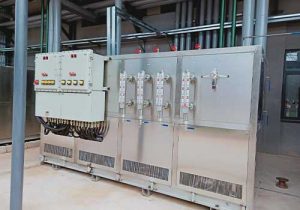air cooled and water cooled
Introduction to Air-Cooled and Water-Cooled Chillers
Chillers are essential in various industrial and commercial facilities for providing cooling to processes, equipment, and spaces. When selecting a chiller system, the decision between air-cooled and water-cooled chillers is critical, as both types have distinct advantages and disadvantages depending on specific requirements. This comprehensive comparison examines their efficiency, applications, environmental impact, and market trends to help determine the most suitable chiller type for different facilities.

Efficiency Comparison
Air-cooled chillers use ambient air to remove heat from the refrigerant, expelling it into the atmosphere through fans and coils. While they are simpler to install and generally have lower upfront costs, they are less energy-efficient compared to water-cooled chillers. Water-cooled chillers use water to remove heat from the refrigerant, with the heat absorbed by the water and then dissipated into the air through a cooling tower. They are more energy-efficient, especially in large facilities, as water is a better heat conductor than air, allowing for more efficient cooling with less energy consumption.
Applications of Air-Cooled and Water-Cooled Chillers
Air-cooled chillers are suitable for water-scarce areas and situations where installation space is limited, as they do not require a cooling tower or extensive piping. They are also preferred in regions with moderate temperatures. On the other hand, water-cooled chillers excel in warmer climates and are used in larger units or high-cooling applications, such as manufacturing, where precise temperature control is essential.

Environmental Impact
Water-cooled chillers are more eco-friendly due to lower heat discharge, and they are often the preferred choice in environmentally regulated areas as they do not release waste materials into the environment. Air-cooled chillers, while not requiring water, can struggle to maintain efficiency in extremely hot climates, which may impact their environmental performance.
Market Trends
The global air-cooled chiller market size was valued at approximately USD 4.5 billion in 2023 and is projected to reach around USD 7.8 billion by 2032, growing at a significant rate. The water-cooled chillers market size reached US$ 4.8 billion in 2023 and is expected to reach US$ 5.6 billion in 2032, exhibiting a growth rate (CAGR) of 3.2% during 2024-2032. Current trends in the water chillers market include the adoption of eco-friendly refrigerants, integration of smart controls and IoT technology, and customization to meet specific customer need.

Conclusion
The choice between air-cooled and water-cooled chillers depends on various factors, including the environment, energy efficiency, initial and long-term costs, and environmental regulations. Air-cooled chillers offer simplicity and ease of installation, while water-cooled chillers provide higher efficiency and quieter operation. Understanding these differences is crucial for selecting the appropriate chiller system that meets the specific needs of an application while considering environmental sustainability and economic viability.
Related recommendations
chiller 24 kw
23024 kW Chillers: An In - Depth AnalysisIntroduction to 24 kW ChillersA 24 kW chiller is a cooling device designed to remove 24 kilowatts of heat from a space or a process. This capacity makes it ...
View detailswater cooler system
356IntroductionWater cooler systems, also known as cooling water systems, play a pivotal role in various industries and everyday applications. Their primary function is to dissipate heat generated b...
View detailsWhy do Chillers need to be Cleaned Regularly?
1657Why do Chillers need to be Cleaned Regularly? Why do chillers need to be cleaned regularly? Because the chiller has been used for a long time, there are often some dirt accumulations in the c...
View detailsWhat Factors Affect the Price of Water-cooled Screw Chillers?
1335What Factors Affect the Price of Water-cooled Screw Chillers? Water-cooled screw chillers are refrigeration equipment that must be used in the production process of many enterprises. However,...
View details
 LNEYA Chiller
LNEYA Chiller







HelloPlease log in